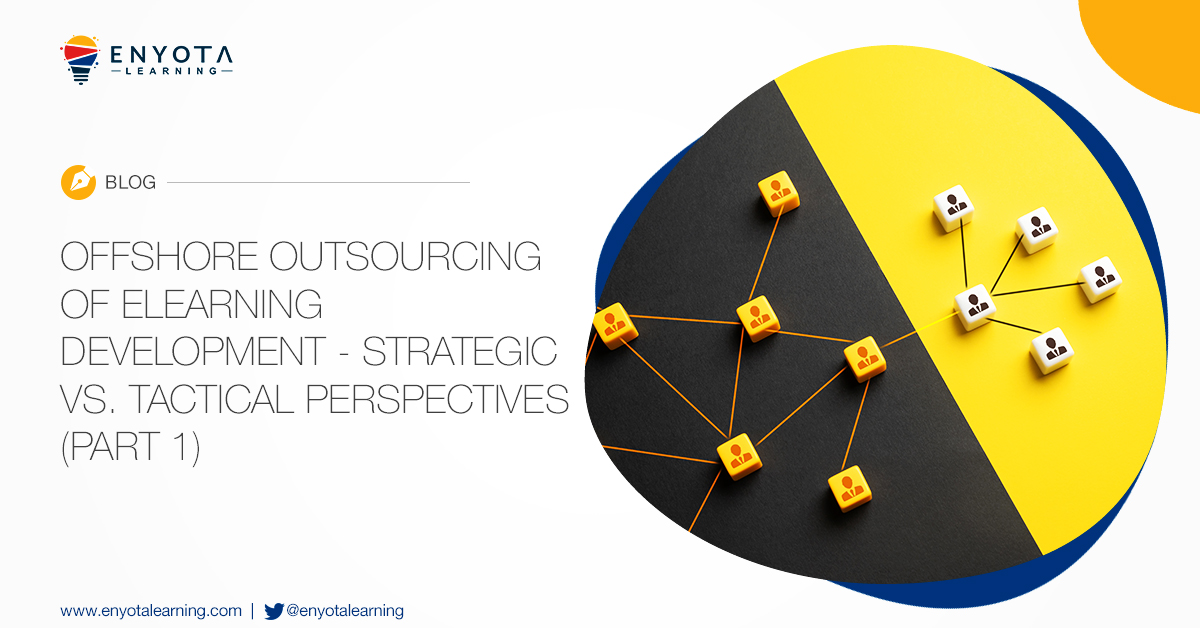The eLearning space is advancing at rapid speeds. With several technological updates and improvements to eLearning authoring tools, the price for developing eLearning has also changed. In some cases, concepts like rapid eLearning developing which aims to cut eLearning development time by up to 50% has significantly reduced the long development cycles and subsequently reduced the cost of developing eLearning. Whereas, in cases where in-depth eLearning is still required, technology has allowed us to do more than what we once could, obviously with increased development costs.
We are eNyota Learning, an eLearning design services agency with a multi-faceted team of 100+ people. We work with various eLearning partners as their extended team. This is so they can do more without investing in an internal team (especially during periods of tight budgets).
With the uncertain situation that COVID 19 has brought with itself, a lot of organizations are continuing to make changes to how they want to train their staff in 2021. This means that digital training is replacing formal methods of training. And if you’re a training company or a corporate that is looking to blend digital training into your offerings, chances are you could have landed yourself in a position where there’s a lot for you to deliver, but you just don’t have the bandwidth.
We partner with multiple corporates and professional training organizations across the globe, helping them execute large projects and take on more than they normally can. However, a common question that arises is about eLearning pricing and what constitutes the cost of eLearning development.
Let’s Breakdown the Rationale Behind Our eLearning Pricing Models

Volume and Seat Time Affects eLearning Costs
Course duration and total number of course elements play a major role in determining the cost of developing an eLearning project. Short, simple, and text-only courses can be used to convey basic training, whereas advanced training needs demand a little more. While the former is very straight forward, the latter requires you to embed several complex courses elements like interactivities, videos, assessments surveys, etc. to assist with knowledge retention. So simpler, shorter courses are faster and easier to build than larger programs (consisting of a large number of learning hours).
Complexity Increases the Price of Development
Next is complexity. Complexity with regard to the content and approach. Here is how we define complexity:
- What is the state of the raw content? Is it readily available or do you need to hire a Subject Matter Expert to write it out for you? The cost needed in bringing together content for your eLearning project forms a big part of the development budget. If you have content in the form of policy documents, classroom training, webinars, seminars, etc., this forms a great base to script your eLearning course. Starting from scratch will affect the costs of your eLearning project. You will need to consider the cost involved in bringing together content for your eLearning project and presenting it in a concise and relevant manner. Since today’s digital learners are always pressed for time, they have no time to go through elaborate course content. Hence always include only the essentials to keep your costs under control.
- eLearning is not the same as traditional training. You do not have instructors conducting a session. Instead, learners are guided by the design which is laid out by instructional designers. And depending on the desired levels of instructional design, the complexity of designing the course increases. Some approaches include a simple template-based approach, or an audio and media driven approach, conversation-based approach, activity-led training, video-based training, or even gamification. From basic programming to converting existing classroom training course materials into an eLearning format or creating new course objectives and content for result-oriented learning – the course design you choose will add to your project costs. The further up the Bloom’s Taxonomy ladder you go, the more complex the instructional design approach gets. Choose the right approach by keeping your learners and budgets in mind.
- Employing interactive elements such as videos, games and simulations will have a direct bearing on your project cost. Depending on your need, you can choose from basic interactive features to very complex ones that tap into learners’ thought processes and encourages them to explore new information, collaborate with others and make decisions. Do you know? A highly interactive course can cost almost two times as much as a basic eLearning course.
- The purchase and inclusion of dynamic UIs, creative design, and modern media elements will also add to your project costs. Although they make eLearning fun and engaging, they needn’t be included in every course. Understand the audience you are catering to and know what you need them to achieve through your eLearning course.
- How responsive your course is will also impact the overall pricing. Since responsiveness is a key element of eLearning courses today, you need to take into account the cost of the responsive design tool as well as the effort that goes in to ensure multi-platform friendliness and easy navigation.
Technology
No matter how basic your eLearning project is, technology will always impact your eLearning costs:
- The cost of integrating your eLearning project with existing Learning Management System (LMS), your HR Management System (HRMS) or any other enterprise system to enhance access and adoption will have to be considered. However,
- since integration can be done at a later stage, start by setting up the most basic integration option and combine complex systems later.
- As mobile usage surges, offering your eLearning course through mobile channels has become a requisite for providing a more engaging learning experience. Enabling mLearning, although necessary, is also costly. So, make sure to include only those aspects that you think are absolutely essential.
- The cost of technology-driven features such as personalization and analytics is also important to improve the adoption and effectiveness of your eLearning project will need to be considered.
- Choosing between an authoring tool or custom development will also decide the cost of your eLearning project.

Team Size
No matter how simple or complex your eLearning project is, you will need to bring together a team of professionals to create training materials and manage your eLearning project. Depending on your need, you will have to take in the costs of SMEs, instructional designers, project managers, researchers, content managers, video editors, proofreaders, graphic designers, software developers, animation experts etc.
Project Duration
Your eLearning project cost will also depend on the time you take to develop it. Time taken will depend on a variety of factors such as information availability, audience understanding, SME availability, design experience, technical expertise, and review experience; hence clearly define your learning objectives and choose a reasonable time frame to ensure the project is completed within cost constraints and at the expected quality.
Development Model
There are two ways in which you can develop your eLearning project: you can either develop it in-house or offshore the project to an experienced partner. The price of eLearning will depend on the model you choose.
In-house development is often more expensive, you will need to take into account operating costs including the purchase of advanced tools and the costs of training existing staff for development purposes.
Outsourced partners can leverage economies of scale, shared resources, and established methods and processes to create efficiencies that help save costs.
Finally Determining eLearning Costs
As modern trends and technologies transform the market, developing cutting-edge eLearning projects in a dynamic environment is extremely challenging. Since several factors impact the price of eLearning projects, it is important to understand and analyze each course and the audience for which it will be developed.
With a good sense of the variables, you can not only achieve your eLearning objectives within the time and budget constraints but also achieve a high ROI.
eLearning Costs should be determined based on your organization’s needs. When engaging, immersive, and informative learning is the objective or creating an environment of continuous learning and development is the foremost priority, cutting back on eLearning costs should not be looked at as an option.
Various elements come together to decide the price of eLearning projects. To know more about the low cost of eLearning or custom pricing for custom courses, do reach out to us at via mail or fill a form and one of our representatives will definitely help you understand eLearning Costs and its parameters. At eNyota Learning, we have over 11+ years of experience to back this up!




